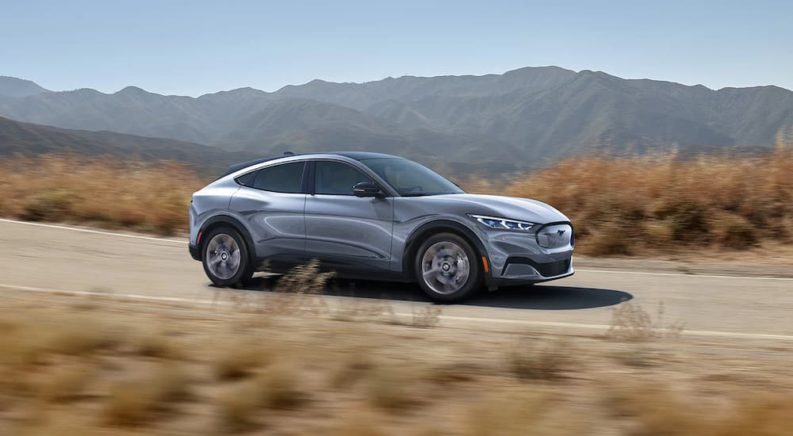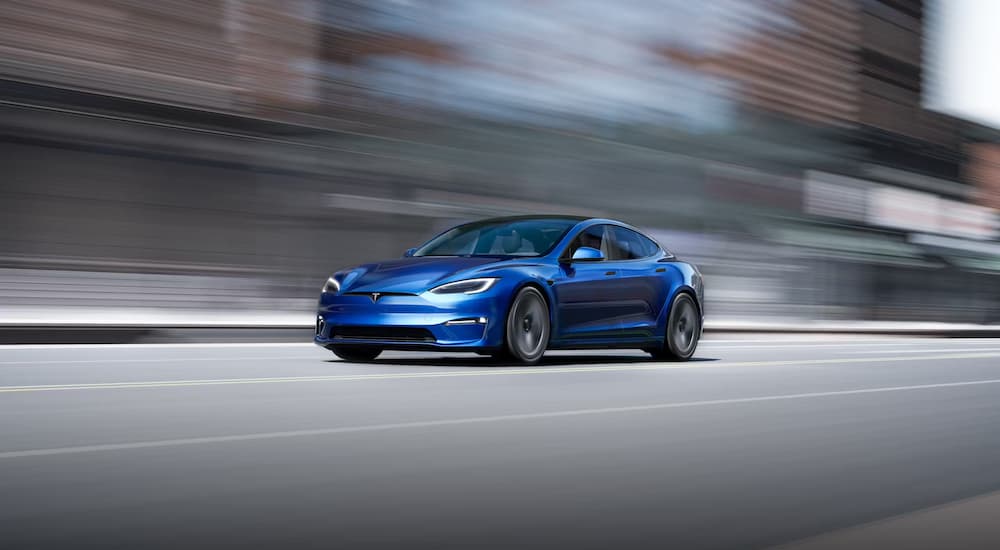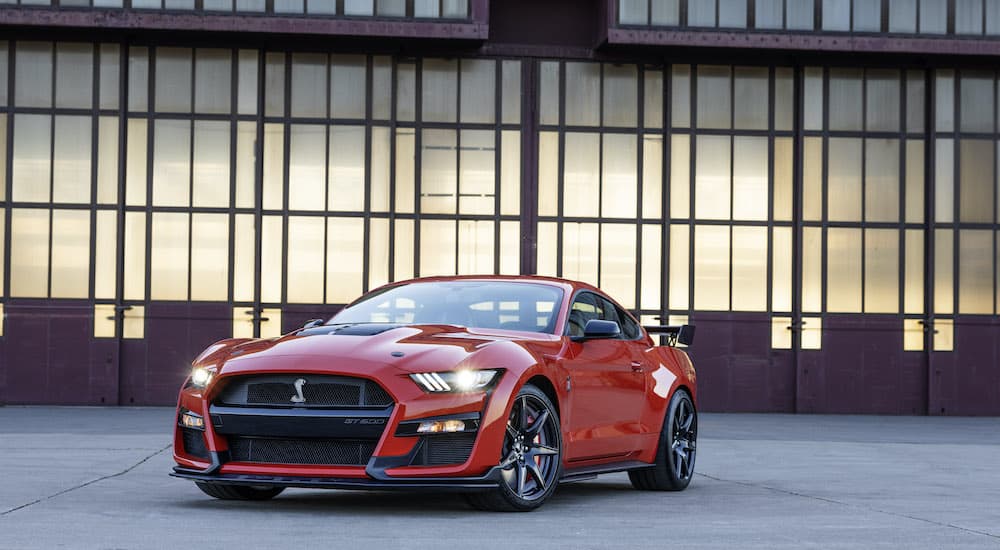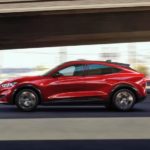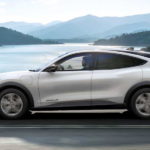If you had asked if the Mustang would turn into an EV just a few years ago, you probably would’ve been laughed out of the proverbial room and reminded that muscle cars will always be about roaring, fiery V8 engines. Of course, with the introduction of the 2022 Ford Mustang Mach-E, particularly the GT Performance Edition, the answer to this question has certainly changed. Now, the possibility of an all-electric future for every model with Ford’s iconic pony insignia seems more likely than ever before.
But is that necessarily a bad thing? I know that EV development and deployment still has a rocky road ahead of it, with plenty of things that need to be figured out, but is the idea of all sports cars being all-electric really something to dread? Those of us who grew up in the ’80s and ’90s, or the decades before, will certainly have some strong feelings about hearing that growling engine; we’re predisposed to associate cylinder count and engine size with raw power. But as the next generation or two take to the road, these old habits will die off, and the performance of EV models will almost certainly speak for itself.
The Big Question
I feel like the big, unstated question in this whole debate is what role do aesthetics play in our sense of what makes a muscle car or sports car? For the last hundred years, vehicle power has been all about the engine, with bigger engines frequently offering more power. Engineers added more cylinders and increased displacement, allowing for more air and fuel to burn, creating more power – while simultaneously designing transmissions and drivetrains that utilized this power as efficiently as possible.
The end result, of course, is that a muscle car sounds different from other types of vehicles. There’s no mistaking the sound of a Ford Mustang or Dodge Challenger with a midsize SUV or a compact sedan. In addition to powerful engines simply sounding different, there’s also been a secondary effort to further associate these two things in our minds by tuning mufflers and exhaust systems to emit powerful, pleasing sounds that we irrevocably link to the power of the engine whenever we hear them.
All of this effort has resulted in a simple aesthetic connection: we associate the sound of an intense, powerful engine with a fast, powerful vehicle. With the development of EVs, however, we now have virtually silent powertrains driven by battery packs and electric motors rather than fuel explosions and pounding pistons. Can we separate our sense of what a sports car sounds like from what sort of performance it actually delivers? The answer to that, to me, is really at the heart of whether people will fully accept all-electric sports cars like a Mustang Shelby EV.
Ford Mustang Models Today
Right now, Ford offers essentially three different vehicles with the name “Mustang” on them: the standard Ford Mustang, the incredibly powerful Mustang Shelby, and the electric Mustang Mach-E. We’re going to ignore this last one for the moment and instead focus on the two traditional Mustangs that are currently offered in Ford’s lineup. In some respects, the standard Mustang is already different from what a lot of people would associate with a sports car or pony car since it comes standard with a 2.3L four-cylinder EcoBoost engine rather than the hulking V8 like you’d expect to find in an all-American muscle car.
Of course, you can still get that 5.0L V8 in the GT trim, and the track-ready Mach 1 has a slightly more powerful version of that same V8. In the past, Ford has offered a larger number of other Mustang options for those searching for more power, but those have been slowly whittled away. Now, the only other gas option is the range-topping Shelby GT500, with its supercharged V8 engine. The higher-spec versions of the Mustang certainly deliver on improved performance. But do these cars really offer something beyond what an EV would be capable of?
Mustangs vs EV Competition
The best way to answer that is to look at what EV models can do when compared to the Mustangs that Ford offers right now. While there are quite a few different EVs available, since we’re talking performance, I think Tesla is the best competition to pit these cars again. Tesla is well known for changing a lot of people’s minds about EV performance with vehicles that are clearly designed to be exhilarating – particularly with the instant electric torque that puts you back in your seat in a way that few other vehicles can.
There are a lot of metrics we could use to compare these vehicles, including horsepower, the aforementioned torque, and more. To keep things neat and simple, however, I’ve chosen to just use one simple stat and see how each of these vehicles stacks up. I’m going to look at how quickly these vehicles can go from 0 to 60 as that’s a great representation of not only raw speed and power but also practical things like getting up to speed as you merge onto a highway. Ford isn’t particularly good at relaying these times, however, so I’m relying on Car and Driver’s testing of the two Mustangs.
- Ford Mustang EcoBoost: 5.0 seconds (with Performance Pack)
- Ford Mustang Mach 1: 4.3 seconds
- Ford Mustang Shelby GT500: 3.4 seconds
- Tesla Model Y Performance: 3.5 seconds
- Tesla Model 3 Performance: 3.1 seconds
- Tesla Model X Plaid: 2.5 seconds
- Tesla Model S Plaid: 1.99 seconds
For reference, none of these Tesla models are designed or marketed as sports cars – the Model 3 and Model S are both roomy four-door sedans, while the Model X and Model Y are SUVs. In fact, the Model X has seating for up to seven people and still blows away all three Mustang models for how quickly it can get up to speed. The results here are pretty simple: the Mustang can’t come close to matching the acceleration that Tesla models deliver.
Of course, as I mentioned earlier, there’s another Mustang available now, the all-electric Mach-E. So how does it compare to the traditional Mustangs and the Tesla models? Let’s take a look.
Mustang vs Mustang
For starters, in case you don’t know, the Ford Mustang Mach-E is an all-electric SUV, and there was quite a lot of controversy over the use of the “Mustang” name for an SUV. That being said, a fair number of early critics have come around based on the already-impressive performance of the Mach-E and the fact that it’s about to get even better with the GT Performance Edition. So how do the Mustangs compare?
- Ford Mustang EcoBoost: 5.0 seconds (with Performance Pack)
- Ford Mustang Mach 1: 4.3 seconds
- Ford Mustang Shelby GT500: 3.4 seconds
- Mustang Mach-E Standard Range RWD: 5.8 seconds
- Mustang Mach-E Extended Range eAWD: 4.8 seconds
- Mustang Mach-E GT Performance Edition: 3.5 sec
Something important to note here: the acceleration time for the Mach-E can vary wildly, even if you don’t look at the GT Performance Edition. There are two battery setups available, an Extended Range and a Standard Range option, with both rear-wheel drive and all-wheel drive offered. This means Mustang Mach-E models range from as slow as 6.1 seconds to as fast as 4.8 seconds, even if you don’t include the GT model. And again, this is an SUV.
Is an EV Future Possible?
Just from looking at acceleration times, it’s pretty clear that EVs can deliver on fantastic levels of get-up-and-go that make them a lot of fun to drive. I didn’t even get into top speeds, but that’s another point where Tesla proves just how impressive these kinds of vehicles can be; the Model 3 has a top speed of 162 mph, while the Model S promises 200 mph once Tesla gets around to rolling out a software update. In other words, assuming all other concerns and issues get figured out, a future with all-EV sports cars would be one that certainly doesn’t lack in power and performance. Engines with the iconic roar we all grew up with might go the way of the dinosaurs that fuel them, but EV Mustangs will be just as fun and heart-pounding to drive as they’ve ever been.

